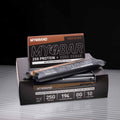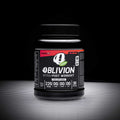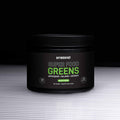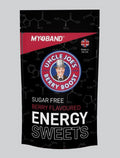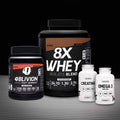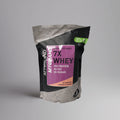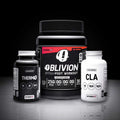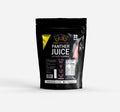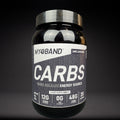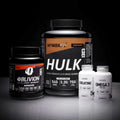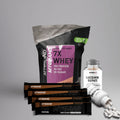‘FOOD n’ FITNESS’: Maximise your workouts and improve your Health
Posted by PROPROTEIN LTD ADMIN

Here at MYOBAND, we believe performance and health go hand in hand. We know that these star pointers are enhanced by the fundamentals of diet and fitness regimes. That being said, it can definitely feel like walking into the unknown when it comes to exercising and eating the diet fit for your fitness. Therefore, we have identified and condensed the core take-home messages to remember, which will help you gain the relevant understanding of how nutrition complements your fitness and most importantly how to implement these messages into your lifestyle.
What is the 80:20 rule?
A popular question amongst the fitness community is “How much should my focus be on fitness and on food?” Well, if there is one thing you can take from reading this blog is the 80:20 rule!
This formula, which has been implemented into many research studies, including a public health investigation on weight management in 2015, is a quick and easy memory tool to indicate where you are in your fitness and health journey. The 80% represents your health focus being towards your nutrition and the remaining 20% of focus should be towards fitness. This equation clearly highlights the importance of nutrition and eating habits to establish positive outcomes in your health. So, for all of you who think you can still get away with perfect fitness routines alongside eating those daily bags of crisps, sweet treats and late-night doner kebabs, it's time to stop giving in to the lie and think again! (1), (2), (3)
Ensuring your nutrition is up to check will not only improve your physique by enhancing workouts, but it also means you don’t have to stress about missing a couple of workouts during the week and feeling guilty for it. This is due to healthy eating habits supporting the main bulk of overall health and fitness needs. This gives you more time to spend doing other valuable things you love during your week. Now, who wouldn't want more of that?
Although dietary needs may depend on the type of physical training you do, the overall components of your diet that are considered nutritionally impactful for any workout include; high protein, moderate intake of healthy carbohydrates (carbs) and healthy fats, all of which have specific food examples that are highlighted further in the article. However, we understand that due to various reasons like time constraints and affordability, it can be difficult to consistently consume balanced pre and post-workout meals/snacks consisting of these food groups. That’s why there are intelligently sourced and formulated supplements promoted by health and fitness brands, like ourselves, who supply a vast array of items such as protein powders for milkshakes and juices to suit your dietary and fitness needs. (4)
Why is nutritional awareness so important to my fitness and athletic training?
Your nutrition and your fitness should always complement each other. Let's look at the reasons why being mindful of what you consume for the gym is important:
- Energy-rich foods or supplements made up of the right complex carbs mixed with non-starch fibres provide you with slow-release energy and smartly regulated nutrient absorption into the bloodstream. It is vital that you have sufficient energy from start to finish to meet the high energy demands of fitness training, particularly post-workout when muscles glycogen stores (the energy store of glucose which is the body's preferred fuel source) need to be replenished. (5)
- Proteins that include essential amino acids (EAAs) which are protein building blocks that our bodies are unable to produce naturally and are necessary for muscle regrowth and development. (5)
- Whole foods or natural supplements concentrated with healthy fats like CLA (Conjugated Linoleic Acid) will help to balance blood sugar levels pre and post workouts while helping to burn those calories and maintaining healthy cell membranes. (5) (6)
- An intricately balanced ratio between carbs and protein will help to combat overall bodily fatigue. They help to reduce that annoying muscular pain induced by DOMS (Delayed Onset Muscular Soreness) caused by microtears within the muscle during exercise. (5) (7)
- Refuelling smartly with micronutrient (vitamins, minerals) dense products help to replace any lost electrolytes from a workout. Electrolytes are essential for maintaining fluid balance and overall cellular function. (4) (5)
How will a carefully planned diet and fitness regime improve my health in the long-term?

You would have to be living under a rock to not be aware of the encouraging nutrition and fitness messages health professionals, media and just about anybody and everybody are promoting at this present time. This is rightly so, as the evidence continues to show that these factors are key essentials for protecting you from multiple complex diseases contributing to a happy long life. Having said that, the bombardment of informed and even misinformed knowledge can easily leave you perplexed as to why both should always be in a tight relationship. Well, here are a few science-backed golden nuggets to remember every time you feel the temptation to pick up that non-nutritious snack or to skip workout day altogether.
- Improving your mood and brain activity:
Most of us are aware that exercise boosts the release of ‘feel-good’ hormones called endorphins in our brains. But to top that, progressive studies show that during muscle contraction, the release of many myokines (a hormone-like protein part of the cytokine family) which help promote other immune cells to aid muscle repair could have a profound effect on cognitive function, as some are transported to the brain where it contributes to the ‘lifted mood’ sensation we get post-workout. Some scientists are even referring to these myokines as ‘hope molecules’. So what better way to inject hopeful feelings than through exercise! (8) (9)
Forgetfulness can be very frustrating and unfortunately as we age it can really impact our quality of life. Therefore doing all that we can whilst our brain cells are young and healthily firing neuronal information is essential to ward off brain diseases such as Alzheimer and dementia later in life. One thing you can do is get that fitness in because research has identified that doing the recommended 150 minutes per week of moderate aerobic fitness or 75 minutes of vigorous training has been discovered to have enlarging effects on the hippocampus, the region of the brain that is responsible for retaining information and learning. This suggests that memory protective benefits exercise has on the brain is worth paying attention to. (10) (11)
Alongside exercise, during recent years nutrition has emerged to have a connection with your cognitive function and emotional wellness with studies linking depressive moods and suppressed cognitive development to low consumption of omega 3 fats (healthy fats). To add to this, the lack of certain vitamins in your diets such as B9 (Folate) and B12 can induce brain fogs and contribute to a lack of mental focus. This reinforces the reason for such a higher nutrient percentage compared to the fitness figure of the 80:20 rule. (10) (12)
- Promote good skin health:
It's been noted that internal body stress (oxidative stress) is reflected on the skin by the increase of free-radicals which are responsible for DNA and cell damage. An increase of these molecules will eventually damage the internal structure of the skin, especially if there are a low level of antioxidants (protective molecules that fight against free-radical damage) circulating within the cells.
Regular moderate exercise can increase the production of antioxidants that are naturally produced by the body to protect your cells from these detrimental molecules. Ultimately, exercise can keep you looking youthful for longer. (13)
They do say the way you take care of your insides is what will show up on the outside. AKA, you need to be fuelling your insides with the right nutrients to glow on the outside! Consumption of highly processed foods full of sugars, fats and salts can leave your skin looking and feeling greasy whilst being a contributing factor to exacerbating pro-inflammatory skin conditions like acne. Instead, eating a blanched diet consisting of micronutrient foods (a variety of fruits, vegetables, beans and pulses) rich in vitamin C will promote the formation of the skin-strengthening-protein collagen which is essential for healthy skin. (14) (15) - Reduce the risk of chronic disease and boost the immune system:
Chronic diseases are illnesses that have developed over a long period of time, are incurable and usually lifestyle-related. Unfortunately, in recent times there has been a surge in chronic disease cases which is impacting health worldwide. This raw reality communicates the duty each of us has in looking after our health. One well-documented way is indeed exercise, where studies show that physical activity can improve insulin sensitivity and cardiovascular health which reduces the risk of all kinds of chronic diseases like obesity, type 2 diabetes and heart disease. (16) (17) (18) (19)
Diet choices are critical in delaying any development of chronic diseases which also weaken your body’s defence mechanism, the immune system. A Meditteranean style or the Nordic influenced diet are considered the golden role models of a healthy diet according to health professionals. This is due to a great focus on food items high in monounsaturated and polyunsaturated fats (i.e. the healthy fats from foods like olive oil, avocado, oily fish) that have cardioprotective benefits. The addition of whole grains and an abundant intake of fruits and vegetables provides these diets with a diverse range of vitamins, minerals and antioxidants that protect long term health. (10) (20) (21)
How do I implement this into my routine?
Here are some quick hot tips to help you start putting this knowledge into practice!
- Eat a healthy breakfast:
Whether you eat breakfast prior or post workouts don't skip that first meal of the day because you need to be properly fuelled for your day ahead and exercise. This will avoid disrupting your appetite regulations and improve overall performance. (22) (23) (24)
Good breakfast options include wholegrain cereals (bran, wheat biscuits), oatmeal, boiled eggs on toast, Greek yoghurt, energy-dense fruit like a banana or to cut the prep-time why not try a powerful protein shake in your favourite flavour! - Snack wisely:
To keep those blood glucose levels consistent throughout the day especially through 60 minute or more workouts, snacking is beneficial but it's about what you snack on that counts. (5) (23)
Healthy snack options include: whole nuts like almonds, fruit, protein concentrated flapjack bar, peanut/nut/sunflower butter with apple or veggie sticks, omelette with avocado on toast. - Eat after you exercise:
Vigorous workouts can leave you feeling fatigued and weak so replenishing used up glycogen stores alongside replacing proteins lost through exercise-related muscle damage is a must. (5) (23) (25)
Meal options/replacements include post-workout protein and carb-rich supplement shake, a carb-based meal with a protein option like a chicken and mayo sandwich on whole grain bread with vegetables, a smoothie rich in a healthy fat like peanut butter (sunflower seed butter is a great alternative to the nut butter if you suffer from a nut allergy). - Keep hydrated:
Before, during and post workouts it is important to stay hydrated. Depending on the intensity and duration of the workout you will lose fluids through sweat and also a varied amount of vital electrolytes (charged molecules responsible for keeping body’s fluid balance at the appropriate level) that need replacing. (26)
Drinks include: 6-8 glasses of water are recommended a day so H2O will always be a perfect option. If you train for 60 minutes or more a sports drink (i.e. a juice-based drink fortified with electrolytes and light carbs). (27)
The Bottom Line:
Food n’ Fitness are like two peas in a pod, without one you won't fully experience the benefit of the other and the vitality both bring to your life. Experience is your guide, so establish a fitness routine that will challenge you and have fun discovering nutrient-rich foods, that will 100% maximise your workouts, to improve your overall health.
References:
(1) Taylor, R., Roy, M., Jospe, M., Osborne, H., Meredith-Jones, K., Williams, S., & Brown, R. (2015). Determining how best to support overweight adults to adhere to lifestyle change: protocol for the SWIFT study. BMC Public Health, 15(1). doi: 10.1186/s12889-015-2205-4 https://www.ncbi.nlm.nih.gov/pmc/articles/PMC4560866/(2) Foster‐Schubert, K., Alfano, C., Duggan, C., Xiao, L., Campbell, K., & Kong, A. et al. (2012). Effect of Diet and Exercise, Alone or Combined, on Weight and Body Composition in Overweight‐to‐Obese Postmenopausal Women. Obesity, 20(8), 1628-1638. doi: 10.1038/oby.2011.76 https://onlinelibrary.wiley.com/doi/full/10.1038/oby.2011.76
(3) Johns, D., Hartmann-Boyce, J., Jebb, S., & Aveyard, P. (2014). Diet or Exercise Interventions vs Combined Behavioral Weight Management Programs: A Systematic Review and Meta-Analysis of Direct Comparisons. Journal Of The Academy Of Nutrition And Dietetics, 114(10), 1557-1568. doi: 10.1016/j.jand.2014.07.005 https://jandonline.org/article/S2212-2672(14)01055-7/fulltext
(4) NUTRITION WORKING GROUP OF THE INTERNATIONAL OLYMPIC COMMITTEE. (2010). Nutrition For Athletes [Ebook] (1st ed.). Lausanne. Retrieved from https://library.olympic.org/Default/doc/SYRACUSE/74010/nutrition-for-athletes-a-practical-guide-to-eating-for-health-and-performance-based-on-an-internatio?_lg=en-GB
(5) Beck, K., Thomson, J., Swift, R., & von Hurst, P. (2015). Role of nutrition in performance enhancement and postexercise recovery. Open Access Journal Of Sports Medicine, 6, 259. doi: 10.2147/oajsm.s33605 https://www.ncbi.nlm.nih.gov/pmc/articles/PMC4540168/
(6) Lehnen, T., da Silva, M., Camacho, A., Marcadenti, A., & Lehnen, A. (2015). A review on effects of conjugated linoleic fatty acid (CLA) upon body composition and energetic metabolism. Journal Of The International Society Of Sports Nutrition, 12(1). doi: 10.1186/s12970-015-0097-4 https://www.ncbi.nlm.nih.gov/pmc/articles/PMC4574006/
(7) Cintineo, H., Arent, M., Antonio, J., & Arent, S. (2018). Effects of Protein Supplementation on Performance and Recovery in Resistance and Endurance Training. Frontiers In Nutrition, 5. doi: 10.3389/fnut.2018.00083https://www.ncbi.nlm.nih.gov/pmc/articles/PMC6142015/
(8) Chaudhry, S., & Gossman, W. (2020). Biochemistry, Endorphin. Retrieved 21 August 2020, from https://www.ncbi.nlm.nih.gov/books/NBK470306/
(9) Bae, J., & Song, W. (2019). Brain and Brawn: Role of Exercise-Induced Myokines. Journal Of Obesity & Metabolic Syndrome, 28(3), 145-147. doi: 10.7570/jomes.2019.28.3.145 https://www.ncbi.nlm.nih.gov/pmc/articles/PMC6774442/
(10) Jackson, P., Pialoux, V., Corbett, D., Drogos, L., Erickson, K., Eskes, G., & Poulin, M. (2016). Promoting brain health through exercise and diet in older adults: a physiological perspective. The Journal Of Physiology, 594(16), 4485-4498. doi: 10.1113/jp271270https://pubmed.ncbi.nlm.nih.gov/27524792/
(11) Bherer L. (2015). Cognitive plasticity in older adults: effects of cognitive training and physical exercise. Annals of the New York Academy of Sciences, 1337, 1–6. https://doi.org/10.1111/nyas.12682
(12) Sathyanarayana Rao, T., Asha, M., Ramesh, B., & Jagannatha Rao, K. (2008). Understanding nutrition, depression and mental illnesses. Indian Journal Of Psychiatry, 50(2), 77. doi: 10.4103/0019-5545.42391 https://www.ncbi.nlm.nih.gov/pmc/articles/PMC2738337/
(13) Kruk, J., & Duchnik, E. (2014). Oxidative stress and skin diseases: possible role of physical activity. Asian Pacific journal of cancer prevention : APJCP, 15(2), 561–568. https://doi.org/10.7314/apjcp.2014.15.2.561
(14) Schagen, S., Zampeli, V., Makrantonaki, E., & Zouboulis, C. (2012). Discovering the link between nutrition and skin aging. Dermato-Endocrinology, 4(3), 298-307. doi: 10.4161/derm.22876 https://www.ncbi.nlm.nih.gov/pmc/articles/PMC3583891/
(15) Draelos Z. D. (2010). Nutrition and enhancing youthful-appearing skin. Clinics in dermatology, 28(4), 400–408. https://doi.org/10.1016/j.clindermatol.2010.03.019
(16) Ross, R., Dagnone, D., Jones, P. J., Smith, H., Paddags, A., Hudson, R., & Janssen, I. (2000). Reduction in obesity and related comorbid conditions after diet-induced weight loss or exercise-induced weight loss in men. A randomized, controlled trial. Annals of internal medicine, 133(2), 92–103. https://doi.org/10.7326/0003-4819-133-2-200007180-00008
(17) Slentz, C. A., Houmard, J. A., & Kraus, W. E. (2009). Exercise, abdominal obesity, skeletal muscle, and metabolic risk: evidence for a dose response. Obesity (Silver Spring, Md.), 17 Suppl 3(0 3), S27–S33. https://doi.org/10.1038/oby.2009.385
(18) Halbert, J. A., Silagy, C. A., Finucane, P., Withers, R. T., Hamdorf, P. A., & Andrews, G. R. (1997). The effectiveness of exercise training in lowering blood pressure: a meta-analysis of randomised controlled trials of 4 weeks or longer. Journal of human hypertension, 11(10), 641–649. https://doi.org/10.1038/sj.jhh.1000509
(19) Booth, F., Roberts, C., & Laye, M. (2012). Lack of Exercise Is a Major Cause of Chronic Diseases. Comprehensive Physiology, 2(2), 1. doi: 10.1002/cphy.c110025 https://www.ncbi.nlm.nih.gov/pmc/articles/PMC4241367/
(20) Ojo, O. (2019). Nutrition and Chronic Conditions. Nutrients, 11(2), 459. doi: 10.3390/nu11020459 https://www.ncbi.nlm.nih.gov/pmc/articles/PMC6412662/
(21) Galbete, C., Kröger, J., Jannasch, F., Iqbal, K., Schwingshackl, L., & Schwedhelm, C. et al. (2018). Nordic diet, Mediterranean diet, and the risk of chronic diseases: the EPIC-Potsdam study. BMC Medicine, 16(1). doi: 10.1186/s12916-018-1082-y https://bmcmedicine.biomedcentral.com/articles/10.1186/s12916-018-1082-y#citeas
(22) Veasey, R., Haskell-Ramsay, C., Kennedy, D., Tiplady, B., & Stevenson, E. (2015). The Effect of Breakfast Prior to Morning Exercise on Cognitive Performance, Mood and Appetite Later in the Day in Habitually Active Women. Nutrients, 7(7), 5712-5732. doi: 10.3390/nu7075250 https://www.ncbi.nlm.nih.gov/pmc/articles/PMC4517027/
(23) Kanter, M. (2018). High-Quality Carbohydrates and Physical Performance. Nutrition Today, 53(1), 35-39. doi: 10.1097/nt.0000000000000238 https://www.ncbi.nlm.nih.gov/pmc/articles/PMC5794245/
(24) Spence, C. (2017). Breakfast: The most important meal of the day?. International Journal Of Gastronomy And Food Science, 8. doi: https://doi.org/10.1016/j.ijgfs.2017.01.003
(25) Murray, B., & Rosenbloom, C. (2018). Fundamentals of glycogen metabolism for coaches and athletes. Nutrition Reviews, 76(4), 243-259. doi: 10.1093/nutrit/nuy001 https://www.ncbi.nlm.nih.gov/pmc/articles/PMC6019055/
(27) Orrù, S., Imperlini, E., Nigro, E., Alfieri, A., Cevenini, A., & Polito, R. et al. (2018). Role of Functional Beverages on Sport Performance and Recovery. Nutrients, 10(10), 1470. doi: 10.3390/nu10101470 https://www.ncbi.nlm.nih.gov/pmc/articles/PMC6213308/
(28) Lee, J., Nio, A., Ang, W., Law, L., & Lim, C. (2011). Effects of ingesting a sports drink during exercise and recovery on subsequent endurance capacity. European Journal Of Sport Science, 11(2), 77-86. doi: 10.1080/17461391.2010.487115 https://www.researchgate.net/publication/254229847_Effects_of_ingesting_a_sports_drink_during_exercise_and_recovery_on_subsequent_endurance_capacity
TAGS:



